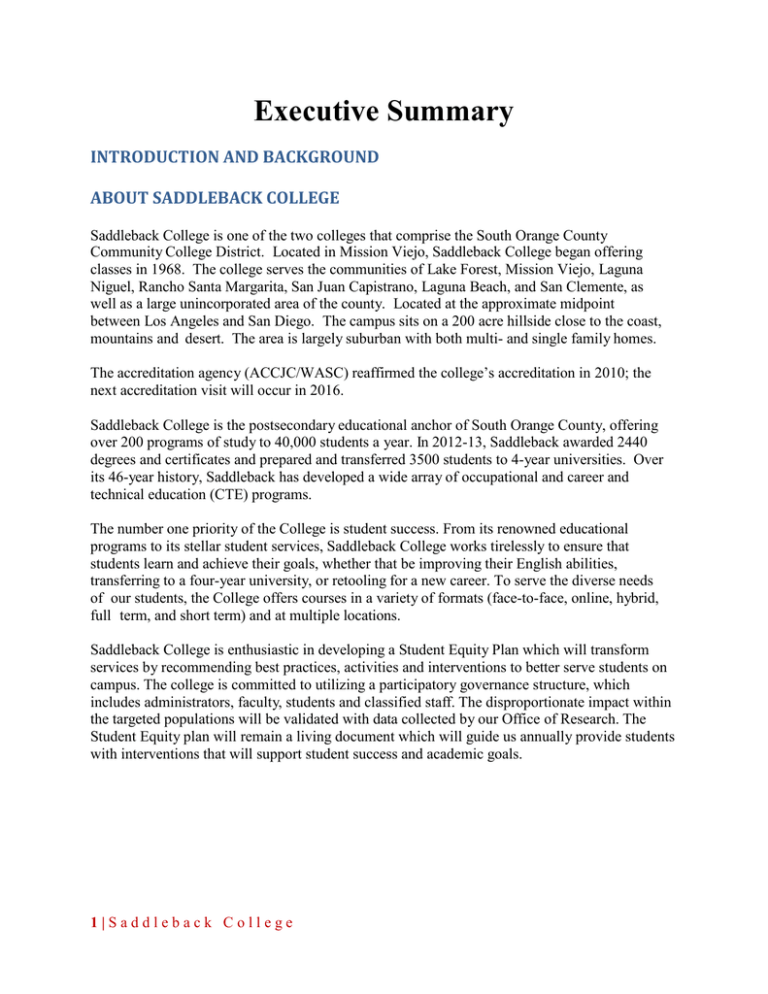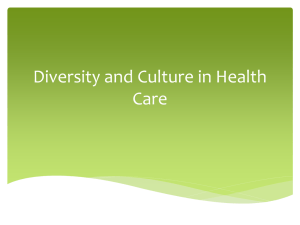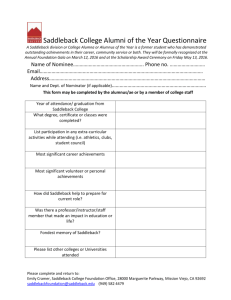Executive Summary INTRODUCTION AND BACKGROUND ABOUT SADDLEBACK COLLEGE
advertisement

Executive Summary INTRODUCTION AND BACKGROUND ABOUT SADDLEBACK COLLEGE Saddleback College is one of the two colleges that comprise the South Orange County Community College District. Located in Mission Viejo, Saddleback College began offering classes in 1968. The college serves the communities of Lake Forest, Mission Viejo, Laguna Niguel, Rancho Santa Margarita, San Juan Capistrano, Laguna Beach, and San Clemente, as well as a large unincorporated area of the county. Located at the approximate midpoint between Los Angeles and San Diego. The campus sits on a 200 acre hillside close to the coast, mountains and desert. The area is largely suburban with both multi- and single family homes. The accreditation agency (ACCJC/WASC) reaffirmed the college’s accreditation in 2010; the next accreditation visit will occur in 2016. Saddleback College is the postsecondary educational anchor of South Orange County, offering over 200 programs of study to 40,000 students a year. In 2012-13, Saddleback awarded 2440 degrees and certificates and prepared and transferred 3500 students to 4-year universities. Over its 46-year history, Saddleback has developed a wide array of occupational and career and technical education (CTE) programs. The number one priority of the College is student success. From its renowned educational programs to its stellar student services, Saddleback College works tirelessly to ensure that students learn and achieve their goals, whether that be improving their English abilities, transferring to a four-year university, or retooling for a new career. To serve the diverse needs of our students, the College offers courses in a variety of formats (face-to-face, online, hybrid, full term, and short term) and at multiple locations. Saddleback College is enthusiastic in developing a Student Equity Plan which will transform services by recommending best practices, activities and interventions to better serve students on campus. The college is committed to utilizing a participatory governance structure, which includes administrators, faculty, students and classified staff. The disproportionate impact within the targeted populations will be validated with data collected by our Office of Research. The Student Equity plan will remain a living document which will guide us annually provide students with interventions that will support student success and academic goals. 1|Saddleback College Target Populations: Saddleback College aligned its target populations with those required for plan development. As a result, our plan was drafted for the following groups: • • • • • • American Indians or Alaska Natives Asian or Pacific Islanders Blacks Hispanics Whites Men • • • • • Women Person with Disabilities Current foster youth Low-income students Veterans Disproportionate Impact Summary of Findings Major Disproportionate Impact (PI ≤ .70): Course Completion Indicator: None ESL & Remedial English and Math Indicator: ESL Completion: Age (35 to 39) Age (40 to 49) Age (50+) Remedial English Completion: Ethnicity (Pacific Islander) Remedial Math Completion: Ethnicity (African-American) Degree and Certificate Completion Indicator: 30-Units Rate Completion: Age (35 to 39) Persistence Rate Completion: None Student Progress and Attainment Rate (SPAR) Completion: Age (20 to 24) Age (25 to 29) Age (35 to 39) Age (40 to 49) Transfer Velocity Indicator: Age (35 to 39) Age (50 +) Ethnicity (Pacific Islander) CalWORKs Students 2|Saddleback College Access Indicator: Age (35 to 39) Age (40 to 49) Age (50+) Disabled Students Economically Disadvantaged Students Veterans Foster Youth Moderate Disproportionate Impact (PI= .71 - .85) Course Completion Indicator: Ethnicity (African-American) Ethnicity (Pacific Islander) ESL & Remedial English and Math Indicator: ESL Completion: Ethnicity (Hispanic) Remedial English Completion: Age (40 to 49) Age (50+) Ethnicity (African-American) Ethnicity (Hispanic) Remedial Math Completion: Ethnicity (Hispanic) Degree and Certificate Completion Indicator: 30-Units Rate Completion: Age (20 to 24) Age (40 to 49) Ethnicity (American-Indian/Alaskan Native) Persistence Rate Completion: Age (17 or Less) Age (20 to 24) Age (35 to 39) Student Progress and Attainment Rate (SPAR) Completion: Age (50+) Ethnicity (African-American) Transfer Velocity Indicator: Age (20 to 24) 3|Saddleback College Age (25 to 29) Age (30 to 34) Age (40 to 49) Ethnicity (African-American) Ethnicity (American Indian/Alaskan Native) Ethnicity (Hispanic) Access Indicator: Gender (Male) Ethnicity (White Non-Hispanic) Mild Disproportionate Impact (PI= .86 - .99) Course Completion Indicator: Gender (Male) Age (18 &19) Age (20 to 24) Age (25 to 29) Ethnicity (American Indian/Alaskan Native) Ethnicity (Hispanic) Ethnicity (Multi-Ethnicity) DSPS Students Veterans Foster Youth ESL & Remedial English and Math Indicator: ESL Completion: Gender (Male) Disabled Students Remedial English Completion: Gender (Male) Age (20 to 24) Age (25 to 29) Age (35 to 39) Ethnicity (American Indian/ Alaskan Native) Disabled Students Economically Disadvantaged Students Foster Youth Students Remedial Math Completion: Gender (Male) Age (18 & 19) Age (20 to 24) Age (25 to 29) Ethnicity (Pacific Islander) 4|Saddleback College Economically Disadvantaged Students Degree and Certificate Completion Indicator: 30-Units Rate Completion: Gender (Male) Age (25 to 29) Age (30 to 34) Age (50+) Ethnicity (African-American) Ethnicity (Hispanic) Persistence Rate Completion: Gender (Male) Age (25 to 29) Age (40 to 49) Ethnicity (African-American) Ethnicity (American Indian/ Alaskan Native) Ethnicity (Hispanic) Economically Disadvantaged Students Student Progress and Attainment Rate (SPAR) Completion: Gender (Male) Age (18 & 19) Age (30 to 34) Ethnicity (American Indian/ Alaskan Native) Ethnicity (Hispanic) Ethnicity (Pacific Islander) Disabled Students Economically Disadvantaged Students Veterans Transfer Velocity Indicator: Gender (Male) Gender (Unknown) Age (18 & 19) Ethnicity (Filipino) Disabled Students Access Indicator: Gender (Male) Age (19 and Less) Ethnicity (Filipino) Disabled Students 5|Saddleback College Goals: Once we identified disproportionate impact within each indicator, as demonstrated by data within each subgroup, goals and interventions were established to address strategies required to assist student achievement rates within the indicators. • Activities: • ACCESS: • AGE (30-39, 40-49, +50) Survey students within the three subpopulation of Age at Saddleback College to uncover factors that challenged and enhanced their academic experiences at the college. Saddleback College will hire one Program Outreach Specialist and Outreach Student Equity Project Specialists to target outreach efforts to the Adult Education community by providing information regarding the matriculation process, financial aid, residency, counseling and other support services that are offered at Saddleback College. This position will recruit and onboard students who would be interested in Adult Education (noncredit course), Career Technical Education, Associate Degrees or Transfer degree. It will focus its outreach efforts in the community and the college target Adults in the disproportionate groups (Adult School programs in the Saddleback Valley Unified School District, Community Centers, Community Libraries, Educational Fair and Saddleback College ESL classes). As High Schools Adult Education programs begin its merge with community colleges as part of the AB 86 initiative, Saddleback College will hire a stipend, full time faculty (non-instructional) position to develop and review of new non-credit curriculum for courses sought out by the adult community. The Re-Entry Center is structured to reach its goals by offering advising, resources, referrals, support groups, and scholarships to returning students. In order to help the efforts of the center, we will house a Part-time counselor aim specifically to help meet the educational needs of adult students. Hire a stipend personnel that will oversee the ongoing planning of the Activities, Goals and Evaluation of the Access Indicator target populations. Provide professional development funding for collegewide personnel to attend training, seminars, workshops, conference or any other event that is identified as a professional development activity by the SEP Chair and/or administrator. 6|Saddleback College • ECONOMICALLY DISADVANTAGED Conduct a survey in order to identify the nature of students’ economic barriers such as time management, academic and/or vocational goals or other challenges that face this target group. • VETERANS Hire a VETS Program Outreach Specialist to provide Saddleback College information regarding the matriculation process, residency, GI Bill, VA assistance, counseling and other support services to the VETS population at north base Camp Pendleton, the Wounded Warriors Battalion, and southern region of the Saddleback College feeder area. This position will also focus on efforts to develop campaigns such as videos, presentation/orientations and update flyers that will communicate college resources more effectively for the disproportionately impacted group. • Develop campaigns to effectively communicate and educate students of financial assistance and college resources with new innovated materials such as, updated handouts, videos, in-person orientations/workshops and multilingual resources. Further, an SEP Financial Aid Specialist along with SEP Financial Aid Ambassadors/ outreach Aides will provide outreach activities focused on financial resources available to students, including specialized populations, EOPS, CalWORKs, DSPS, VETS, Active Military, Foster Youth, and High Schools and ROP programs in the Saddleback College service area. In efforts to improve our student support services, we will expand counseling services to active military and Veterans at various locations such as, Camp Pendleton and the southern region of the Saddleback College feeder area. By incorporation one to two part-time Veterans counseling positions it will improve capacity (quality and quantity). COURSE COMPLETION • ETHNICITY (African Americans) Organize focus groups of African-American students to better understand the needs of the African-American student population. Utilize focus group discussions to collect opinions about on-campus support, use of programs, the impact of college Student Success and Student Equity's efforts, etc. Focus groups will be led by Research and Planning. Provide resources for college-wide professional development to train faculty and staff on how to assist African-American students in overcoming barriers that impede course completion. Institute first-year experience learning communities that will link counseling courses in math and English courses. Students will move 7|Saddleback College through the first year as a cohort while linked to a supportive counseling course. • Deliver outreach to African-American students to encourage participation in student services dedicated to course completion, including: Counseling, tutoring, and learning communities. Students will receive outreach through in-person contact with counselors/student mentors, emails, and nudges. Hire SEP research manager funded 100% through SEP. Hire additional peer mentors (of similar ethnic/racial background) to improve student support in the learning communities and throughout campus. ESL AND BASIC SKILLS COMPLETION • AGE (35-39, 40-49, 50+/BSI-ESL, 40-49, 50+/BSI-English) Confirm whether students are taking ESL courses for social rather than academic reasons: Determine educational goals of the students in the identified group, as well as the number/percentage who are enrolled in college-level ESL or college-level English; who have enrolled only in ESL classes; who are still enrolled at Saddleback; and the number/ percentage of students who stayed at Saddleback for more than one year. Determine their employment status and the number of hours employed per week. Investigate if students are applying for financial aid, and the type of aid they are applying for (e.g., BOG fee waiver, Pell Grant, work study, etc.). Investigate if students are entering the workforce immediately after attending Saddleback. Determine if they are taking only 30 units and leaving upon disqualification for further financial aid, or if they are taking one or two classes. Determine the percentage of students who are impacted by external factors (e.g., family barriers and crises). Educate faculty and staff about expanding services available (financial aid, tutoring, etc.) for students in this age group. Counselors outreach to ESL classes to encourage use of services. 8|Saddleback College • Financial aid workshops for students interested in Financial Literacy. Consider developing a community education platform for students who just want to take a course for social reasons. Continue to extend hours of LRC (Learning Resource Center) on campus (earlier before classes meet and later into the evening, from 8 am – 8 pm) and Saturday morning tutoring (9 am-2 pm). Establish an online tutoring platform. Extend the online tutoring platform to include instructor office hours. Connect with faculty from ESL to begin offering office hours online through this platform. During the in-person ESL group advisement, not only have a counselor conduct the advisement, but also have an ESL instructor present. Consider alternative locations and times of ESL courses. Create a learning community with the Advanced ESL courses and the Counseling 160 course. Enhance Career and Job Placement Services to include developing resumes, cover letters, interviewing skills, internships, customer service skills, and job training, etc.… ETHNICITY (African American/BSI-English, African American/BSI- Math, Pacific Islander/BSI-English, Hispanic/BSI-Math) Create 1 part time (20hr/week), student equity case managers who will meet with the aforementioned cohort on a weekly basis in order to connect students with resources on campus, including but not limited to academic/student support services: counseling, financial aid, EOPS, DSPS, library services, tutoring services, mental/emotional health support, counseling, and health center. Additionally, the case manager will meet with students on a weekly basis and provide academic support by ensuring students are prepared for quizzes, exams, essays, and other academic activities for their course offerings. Create 1 full time (40hr/week), student equity case managers who will meet with the aforementioned cohort on a weekly basis in order to connect students with resources on campus, including but not limited to academic/student support services: counseling, financial aid, EOPS, 9|Saddleback College DSPS, library services, tutoring services, mental/emotional health support, counseling, and health center. • • (This full time position will support both the efforts and goals of both the ESL/BSI and Completion cohorts). DEGREE & CERTIFICATE • AGE (20-24, 25-29, 35-39, 40-49) Conduct qualitative research on the particular needs of students who start college for the first time one or more years after graduating from high school (“gap” students) such as financial needs, childcare needs, time constraints due to work schedules, etc. This can be done, in part, by adding questions to the biannual student survey from targeted populations. Identify the negative impact from GI Bill max. period (36 months) on Veterans’ Degree and Certificate completion rate by coordinating closely with Veteran’s Office. Align the local GE pattern with Title 5, to comply with CSU and IGETC GE regulations (18 units). Expand peer-led Supplemental Instruction programs targeted specifically for this age group. Create a peer mentor program, using AVID model, targeted specifically for this age group. Create “Fast Track Pathway” activities modeled after the Freshman Advantage but targeted towards the “gap” students. TRANSFER • ETHNICITY (Hispanic) Develop mentoring, campus visit and community service opportunities for Hispanic students with a focus on transfer. The Chicano, Latino, Access, Success & Empowerment (CLASE) Transfer Mentor Program will be a peer-to-peer mentoring program in which current students (with more than 40 units) and alumni who have recently transferred will provide mentoring and develop programs for new Hispanic students with a focus on providing transfer access, transfer success & transfer empowerment. In addition, Chicano/a-Latino/a students with Spanish speaking parents will be included in a summer transfer overview meeting conducted in Spanish (Una Tarde: Exitos). Students, parents and siblings will be invited. Refreshments were provided for the inaugural Exitos event by the Transfer Center and a Spanish-speaking counselor from the Transfer Center will be present to answer transfer related questions of a technical nature. 10 | S a d d l e b a c k C o l l e g e • AGE (35-39, 50+) • There exists a drop in Transfer Velocity after six years for students who begin college after reaching age 20. Research will be conducted on students who enter college at age 20 and older to determine their college goals, needs and possible activities to facilitate transfer for this group. Suggested research activities include surveys, interviews, focus groups and exit surveys for those who withdraw from classes. DISABILITY STATUS Conduct research to help determine why students with disabilities are transferring at a lower rate after six years than students without disabilities. Conduct transcript studies to determine possible drop off points and possible gatekeeper courses. Survey students when they withdraw from classes to determine reasons for class changes or withdrawals. Work with Disabled Students Programs and Services (DSPS) and the Career Center to determine ways that the Transfer Center can collaborate with this and other services to increase transfer opportunities for this student population. Explore options for speakers directed at transfer and career opportunities for students with disabilities. Educate faculty and counselors on careers/majors for students with disabilities. 11 | S a d d l e b a c k C o l l e g e




